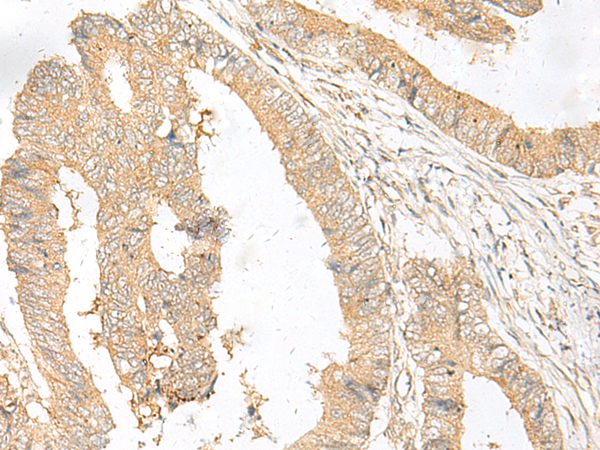
| WB | 咨询技术 | Human,Mouse,Rat |
| IF | 咨询技术 | Human,Mouse,Rat |
| IHC | 1/25-1/100 | Human,Mouse,Rat |
| ICC | 技术咨询 | Human,Mouse,Rat |
| FCM | 咨询技术 | Human,Mouse,Rat |
| Elisa | 1/5000-1/10000 | Human,Mouse,Rat |
| Aliases | SELR; SELX; SepR; SEPX1; HSPC270 |
| Host/Isotype | Rabbit IgG |
| Antibody Type | Primary antibody |
| Storage | Store at 4°C short term. Aliquot and store at -20°C long term. Avoid freeze/thaw cycles. |
| Species Reactivity | Human |
| Immunogen | Synthetic peptide of human MSRB1 |
| Formulation | Purified antibody in PBS with 0.05% sodium azide and 50% glycerol. |
+ +
以下是关于MSRB1抗体的3篇参考文献摘要:
---
1. **文献名称**:*Mammalian methionine sulfoxide reductase B1: Characterization and regulation of expression*
**作者**:Vadim N. Gladyshev 等
**摘要**:该研究鉴定了哺乳动物MSRB1作为依赖硒半胱氨酸的甲硫氨酸亚砜还原酶,通过特异性抗体检测其在组织中的广泛表达,并发现其通过修复氧化损伤的甲硫氨酸残基参与细胞抗氧化防御系统。
2. **文献名称**:*MsrB1 regulates oxidative stress via Nrf2 signaling in mammalian cells*
**作者**:Byung Cheon Lee 等
**摘要**:利用MSRB1抗体进行亚细胞定位分析,发现MSRB1通过激活Nrf2通路增强抗氧化基因表达,揭示了其在氧化应激保护中的分子机制,并证明其缺失加剧细胞氧化损伤。
3. **文献名称**:*Association of MsrB1 with Alzheimer’s disease pathology in mouse models*
**作者**:Jung-Keun Hyun 等
**摘要**:通过免疫组化与Western blot分析,研究显示阿尔茨海默病模型小鼠脑组织中MSRB1蛋白水平显著下降,提示其表达减少可能与β-淀粉样蛋白毒性导致的神经元氧化损伤相关。
---
这些文献涵盖了MSRB1的功能机制、调控通路及疾病关联研究,抗体技术在其中主要用于蛋白定位及定量分析。如需具体文献来源,建议通过PubMed或Google Scholar按作者及标题检索。
The MSRB1 antibody targets methionine sulfoxide reductase B1 (MSRB1), an enzyme critical for repairing oxidative damage to methionine residues in proteins. As part of the methionine sulfoxide reductase (MSR) family, MSRB1 specifically reduces methionine-R-sulfoxide back to methionine, counteracting oxidative stress-induced protein dysfunction. This enzyme localizes to mitochondria and the endoplasmic reticulum, playing a key role in cellular antioxidant defense and maintaining protein homeostasis. Dysregulation of MSRB1 has been implicated in aging, neurodegenerative disorders (e.g., Alzheimer’s and Parkinson’s), cardiovascular diseases, and cancer, making it a focus of biomedical research.
MSRB1 antibodies are widely used in techniques like Western blotting, immunohistochemistry (IHC), immunofluorescence (IF), and flow cytometry to study the enzyme’s expression, localization, and regulatory roles. Commercial antibodies are available from suppliers such as Abcam, Cell Signaling Technology, and Santa Cruz Biotechnology. Researchers rely on these tools to investigate tissue-specific expression patterns, disease-associated alterations, and MSRB1’s interaction networks. However, variability in antibody performance across applications or sample types necessitates validation via knockout controls or peptide blocking experiments.
Quality control is essential, as batch-to-batch differences can affect specificity. Proper validation ensures accurate detection of the ~12-15 kDa protein and avoids cross-reactivity with other MSR family members. Studies using validated MSRB1 antibodies have advanced understanding of its protective mechanisms in oxidative stress-related pathologies, highlighting its potential as a therapeutic target or biomarker.
×